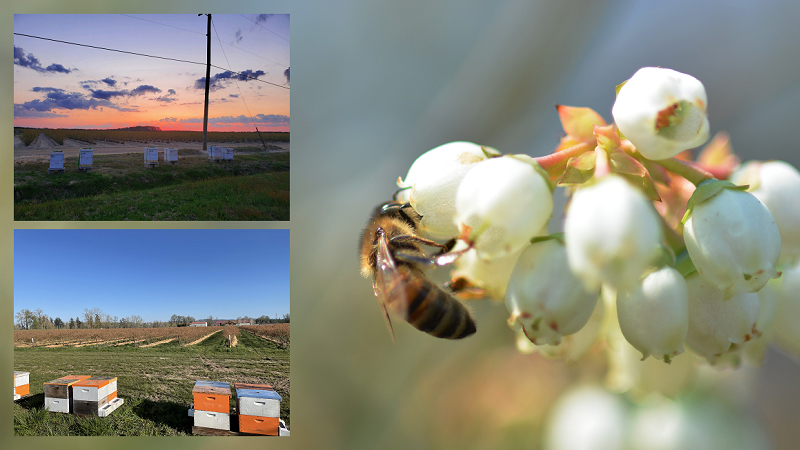Researchers Still Have a Lot to Learn about Spotted Lanternfly

An egg mass-covered end post in a vineyard within the quarantine zone this spring.
Photo: Erica Smyers, PSU
When the spotted lanternfly was initially found in Berks County, PA, in September 2014, the Keystone State was on high alert — given the pest’s destructive history in Korea and potential economic impact. This sap-feeding planthopper is native to China, India, Japan, and Vietnam. But, it is an invasive species in Korea, where it is known to attack 67 host species – including grapes, apples, and stone fruit.
But in the U.S., its impact has been difficult to predict. While researchers at Penn State University and the Pennsylvania Department of Agriculture anticipated its feeding habits would be similar to those in Korea, the pest has been choosy in the states.
What has been surprising, says Michael Saunders, Penn State University Professor of Entomology, is the rate at which the population has increased in the quarantine zone in the past two years.
While the pest avoids fruits, according to literature from Korea, it attacks grapevines in two ways: direct feeding and through sooty mold from the pest’s honeydew secretions.
“Direct feeding by large numbers of adults will depress vine growth and vigor, and the honeydew excretion from spotted lanternfly can cover leaves and fruit which subsequently become coated with sooty mold,” Saunders says. “Sooty mold can make grape clusters unmarketable and can cause leaves to be unable to photosynthesize.”
Dana Rhodes, State Plant Regulatory Official with the Pennsylvania Department of Agriculture, says the feeding has not affected plant growth.
“We have not seen diminished growth at this point, but again we are only into this a couple of years,” she says.
Saunders says the younger life stages are unlikely to inflict much damage on grapevines, “but the oldest nymphal stage and the adults can pose significant risks to vineyards if not treated.”
But there’s more than just damage to vines, Saunders says of the “strikingly lovely insect capable of making life miserable for everyone, not just farmers but homeowners.
“Imagine walking into your wooded property and being bombarded with sticky honeydew. Your shoes are ruined, your hair is sticky, and your glasses are too smeared to see out of. We have been to sites like this, and with the increasing numbers of spotted lanternfly, we expect to see a lot more.”
Enigmatic Pest
Studying this pest, which in the Fulgorid family of planthoppers, has been an important part of the process. In fact, they’re learning more about this enigmatic pest all the time.
“Our graduate student, Erica Smyers, has documented a number of behaviors never before seen in Fulgorid planthoppers. These involve feeding behaviors, feeding site competitions, mating behaviors, etc.,” Saunders says. “Erica is spending the spring and summer living in the quarantine zone so as to better study spotted lanternfly and its impacts on grapes.”
Saunders urges Pennsylvania grape growers to be vigilant. There are still some unknowns about the effectiveness of applications.
“There are a number of compounds that are currently registered in Pennsylvania for grapes that have been tested in Korea for spotted lanternfly control,” he says. “These insects should not be hard to kill, but we know little about how intense the population pressures can become. For example, we don’t know if a single insecticide application late in the season provides all the control that will be needed, or if multiple applications over a longer time period may be required.”
Get Rid of Egg Masses
For now, the research team feels scouting and eliminating egg masses are an important part of controlling the spread of this pest. Adults, easily identifiable by their distinctive markings, are active August through December.
“Destruction of egg masses are very effective,” Rhodes says. “One egg mass contains 40 to 50 eggs. Egg masses should be scraped in a downward motion and placed in a plastic bag with rubbing alcohol or hand sanitizer. Finding it early is important since so many eggs are in each egg mass.”
“We are just going into our third year of survey. We are working with orchards, grape growers, and hop growers in the quarantine to try and learn more.”
Looking to the Future
Rhodes says she received a report of spotted lanternflies on hops last year, which will be added to the crops to study. It’s also important for those outside of the quarantine area in Pennsylvania to report any pests spotted. It is believed the pest was spread through egg masses being moved.
“The sooner we know about a population the better our chances are in control,” Rhodes says. “If you think you have spotted lanternfly you may report it to 866-253-7189 or email [email protected].”
Rhodes says there is also a promising biocontrol – a parasitoid which was released to control gypsy moths – which happened to also prey on the spotted lanternfly.
“This parasitoid has been found around the spotted lanternfly egg masses. We are encouraged by this. The Pennsylvania Department of Natural Resources has taken the lead in exploring this more. They have found some parasitism with the spotted lanternfly from the parasitoid. Biocontrols are always welcome when they are already established, as it saves time and research.”










